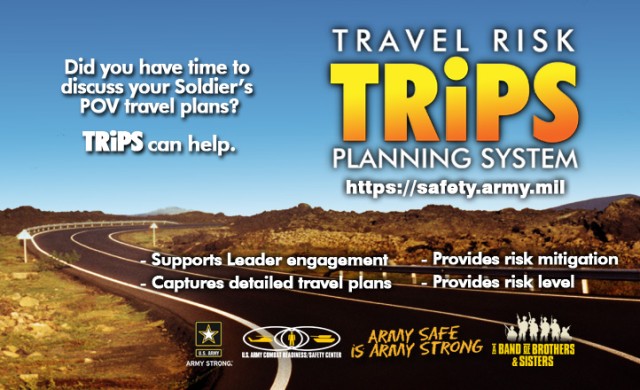
FORT RUCKER, Ala. -- The season of holiday travel is here, and Soldiers driving to and from their destinations could encounter any number of hazards along the way. The Army's Travel Risk Planning System risk assessment tool, found online at the U.S. Army Combat Readiness/Safety Center website, is a great resource to get Soldiers started safely on their holiday getaways.
All Soldiers planning to drive a privately owned vehicle on pass, leave, temporary duty or permanent change of station travel orders outside their immediate local area are required to complete a TRiPS assessment before their departure date. The tool allows supervisors to review a Soldier's travel plans for potential safety issues and open dialogue on how to further mitigate risk, especially off duty.
TRiPS, originally released Army-wide in fiscal 2004, has proven successful in helping reduce driving fatalities every year since its inception.
"In fiscal 2010, active-duty Army fatalities while on TRiPS assessed travel was only 17 percent of total fatalities occurring outside of 150 miles from the installation," according to Derek Kovacsy, automated risk tools program manager at the USACR/Safety Center. "It's been so effective that all the other military services have adopted it."
The key to the program's success is leader involvement, said Kovacsy. The tool provides leaders with important details about their Soldiers' plans, overall risk and options to mitigate hazards during specific trips. Armed with vital facts, leaders may then approve or disapprove the online assessment and request the Soldier alter his or her travel to reduce identified risks. This leader-to-subordinate interaction, fostered by TRiPS, is crucial to Soldier safety during long trips away from home station.
Despite its effectiveness, TRiPS is not intended to replace the supervisor's role in approving leave, nor should it become a check-the-block system to provide a paper trail after an accident, said Kovacsy. The intent is to empower leaders with the facts and bring them face-to-face with their Soldiers to better protect and inform them of driving hazards.
Soldiers using the tool during the 2010 holiday exodus can take advantage of a new "comments" section added during the past few months.
"With this enhancement, both supervisors and subordinates can now convey thoughts not captured in the automated assessment," Kovacsy explained. "We are also working on updating the motorcycle section to be more comprehensive for Soldiers riding to their destinations."
Soldiers can find the tool online at https://safety.army.mil/.

Social Sharing